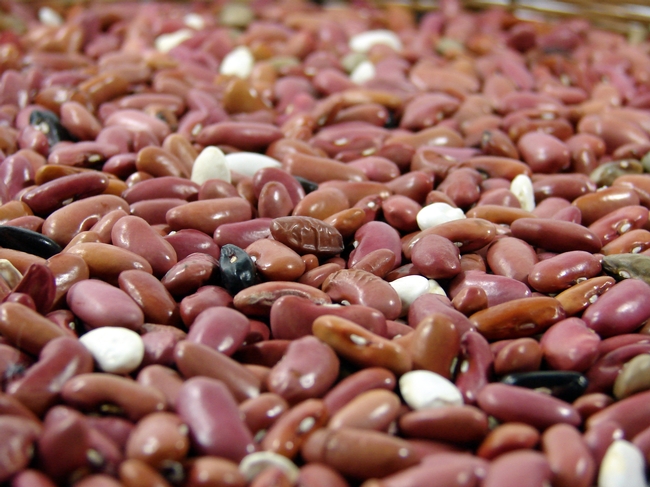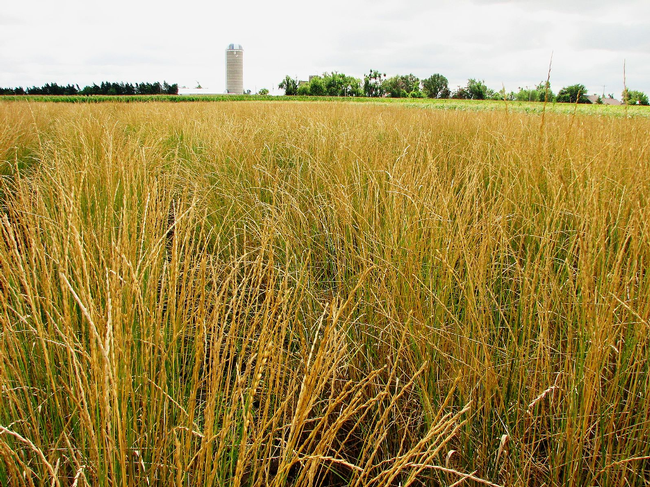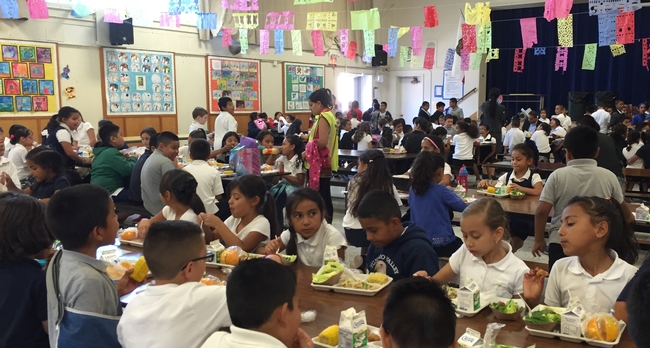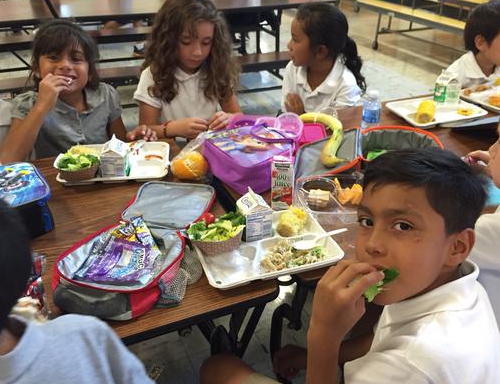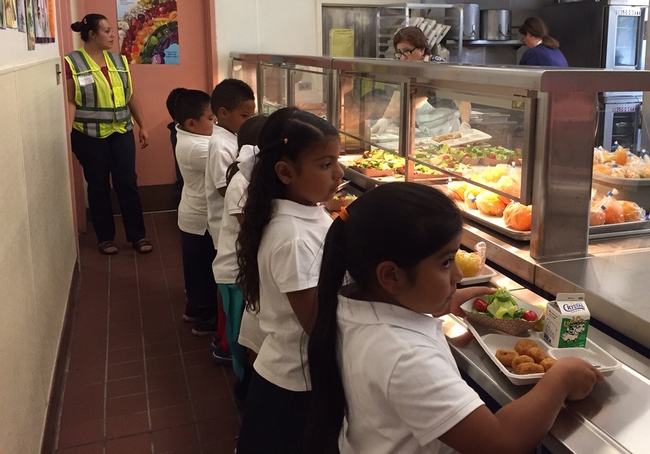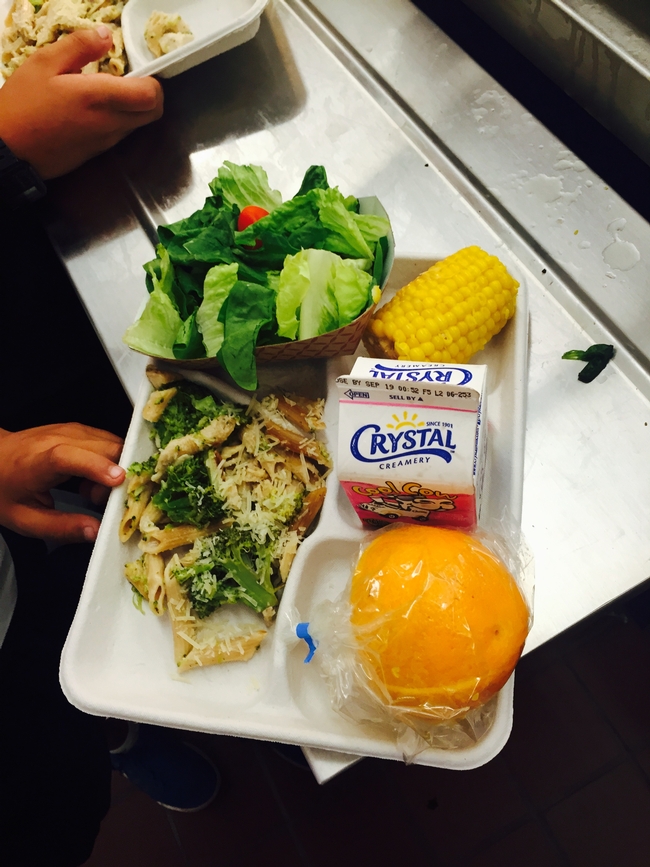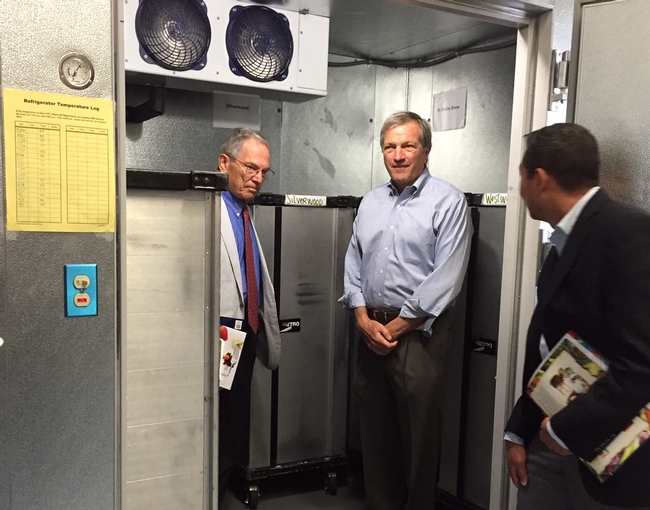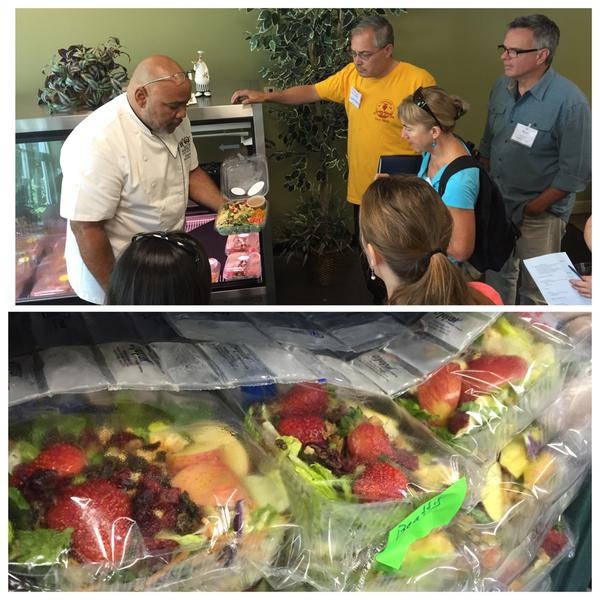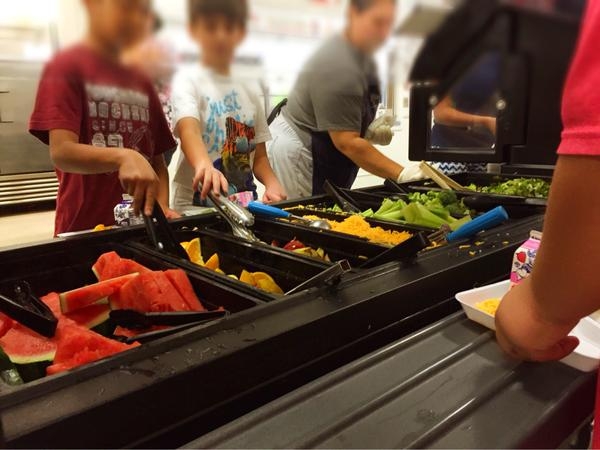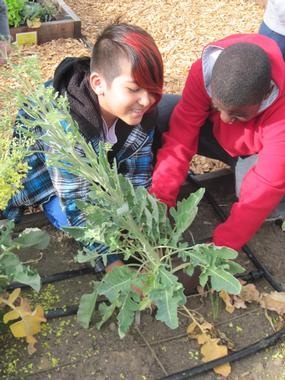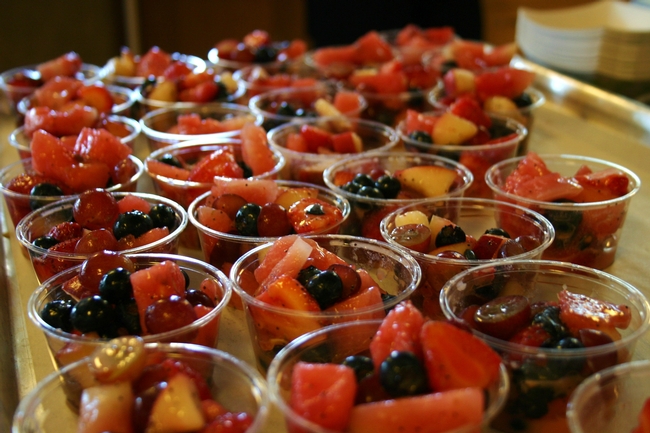Posts Tagged: Gail Feenstra
Building institutional markets for plant-based proteins
This spring, the University of California Sustainable Agriculture Research and Education Program (UC SAREP) is joining a nationwide effort led by the non-profit Health Care Without Harm to build new markets in the healthcare sector for locally produced plant proteins.
More than 39% of Americans are looking to incorporate more plant-based foods into their diets (1). High-protein legume crops, like peas and beans, help meet this consumer demand for more “plant-forward” diets while also benefiting the environment through their role in building healthy farm soils.
Connecting producers of plant-based proteins to nearby hospitals through farm-to-hospital programs can be a win-win for participants — producers benefit from a new market while hospitals advance their mission to promote and protect community health through better diet-based interventions (2).
The success of a farm-to-hospital program hinges on building successful collaborations and sometimes requires restructuring existing contracts or exploring new ones.
“Local food purchasing can be challenging with hospital food supply chains,” says Gail Feenstra of UC SAREP. “But the interest is there: sourcing local fresh foods and plant-based protein is good for diets and for regional prosperity. Hospitals and producers sometimes need someone to help bring them together to figure out how everyone can benefit. That's where this project comes in.”
The project team, which also includes the Community Alliance with Family Farmers, Colorado State University Extension and Ecotrust, will be organizing a series of events in the coming year connecting health care representatives with producers in their regions.
These “meet and greets” will give health care representatives an opportunity to share their needs for plant proteins and prepared products they'd like, and arrange special purchasing agreements with local producers.
Project participants will also receive support from Health Care Without Harm and be given access to a suite of Plant-Forward Future resources that will help them to be successful in implementing plant-forward menus.
UC SAREP is recruiting California-based producers, processors and value-added product manufacturers of plant proteins (especially dry pulses and fresh peas and beans) who are interested in learning more about selling to the health care sector.
As part of its mission of sustainability in regional food systems, UC ANR partners with communities to help ensure fresh, local food is finding its way to consumers through a growing number of channels, including farm-to-institution programs.
UC ANR helps accelerate cultivation, marketing of the perennial grain Kernza
As part of its mission of sustainability in agriculture, the University of California Sustainable Agriculture Research and Education Program (UC SAREP) is interested in crops that hold environmental and economic promise — such as moringa, the drought-tolerant “superfood” grown by Central Valley farmers, or elderberry, offering carbon sequestration and pollinator benefits when planted in hedgerows.
In this vein, UC SAREP is part of a recently awarded $10 million grant from USDA focusing on the adoption of a perennial grain, Kernza®, as a means to shift U.S. agriculture towards reduced tillage and increased carbon sequestration.
The Kernza-CAP project is led by Jacob Jungers of the University of Minnesota. The project team includes researchers, farmers, educators, industry leaders, policy experts and climate scientists at 10 universities and 24 non-profit and farm and food organizations nationwide.
Kernza is the trademark name for the grain bred from intermediate wheatgrass (Thinopyrum intermedium), a non-native perennial forage grass from Eurasia introduced to the U.S. in the early 20th century.
While intermediate wheatgrass has been grown for decades in the U.S. as a forage crop, its use as a commercial grain crop for human consumption is new. Breeding efforts with Kernza have focused on traits to make intermediate wheatgrass a profitable grain crop, including increased seed yield and seed size. (Kernza is traditionally bred and is not a genetically modified crop.)
Kernza has strong potential to benefit the environment and increase farm income by producing both a premium grain and a high volume of quality straw.
As a perennial, Kernza can be harvested for several years in a row, avoiding the cycle of annual tillage resulting in carbon loss, erosion and soil degradation. The deep roots of the crop — up to 10 feet in depth — is naturally occurring, promoting carbon sequestration and increased water infiltration and mimicking native prairie grasses.
Research and early production trials have shown that Kernza can reduce seed, fertilizer and machinery costs for farmers. And, because its grain is high in protein, fat and fiber, it can be used to make flour, crackers, tortillas, bread, pasta, granola, cereal, beer and whiskey.
Kernza is being strongly promoted to early-adopter growers as a dual-use crop for grain and forage. But because it is a new crop, strong relationships with businesses in various agricultural sectors are needed to expand early adoption of processing, transporting and incorporating Kernza into farmers' operations and food products.
“A big stumbling block for getting emerging crops like Kernza off the ground is the capacity to build a community of growers, processors and sellers who can form that new supply chain,” says Gail Feenstra, UC SAREP director and Kernza-CAP team member.
“SAREP's role in the Kernza-CAP project is as something of a ‘matchmaker,' connecting the market potential in California to the nationwide Kernza coalition. We'll be convening growers, millers, bakers and brewers to figure out practical steps for adoption,” says Gwenaël Engelskirchen of UC SAREP. “In the later years of the project, we'll be looking for growers who might be interested in trialing Kernza in California.”
The Kernza-CAP project launched on Sept. 1, 2020. Results from the five-year project will include new cultivars that yield more grain and enhance critical ecosystem services, a better understanding of those ecosystem services, best practices for Kernza growers, supportive policy and educational tools, and multiple operating regional supply chains meeting increased national market demand for Kernza.
More information on Kernza, the project partners, updates and reports on research findings, additional press materials, and field day demonstration information can be found on kernza.org/kernzacap.
The Kernza trademark is owned and managed by The Land Institute, a non-profit research organization based in Salina, Kansas that is playing a critical role in developing Kernza and other perennial crops. This work is supported by AFRI Sustainable Agricultural Systems Coordinated Agricultural Program (SAS-CAP) grant no. 2020-68012-31934 from the USDA National Institute of Food and Agriculture.
Farm to fingers: Schools provide fresh fruits and vegetables for children’s meals
Several grade school students set down their forks to eat their green salad, picking up individual lettuce leaves with their fingers and pushing them into their mouths. Not that I was there to judge for style, it was just an observation as I looked around the cafeteria festooned in colorful hand-cut paper banners to see how many of the kids had taken a salad.
The youngsters are required to take at least a half-cup serving of fresh fruits or vegetables as part of a healthful meal to meet national nutrition standards, but I noticed they were voluntarily eating the fresh leafy greens and orange slices.
The children had selected the food themselves from a new serving line, which was made possible by a grant from the USDA aimed at encouraging children to eat healthier school lunches. U.S. Department of Agriculture has been providing a new round of grants since 2013 to upgrade kitchen and cafeteria equipment. Ygnacio Valley Elementary School is in Mount Diablo Unified School District, which received a USDA grant.
About one-third of children in California are overweight or obese, which is associated with serious health risks.
According to The Pew Charitable Trusts, 93 percent of school districts in California, and 88 percent nationwide, need at least one piece of equipment to better serve students nutritious foods.
Kenneth Hecht, director of policy for the Nutrition Policy Institute organized the Sept. 3 visit to the Mount Diablo Unified School District for Congressman Mark DeSaulnier and USDA executives to see the improvements.
The school district serves about 20,000 meals each day, nearly half of which (46.2 percent) are free or reduced price for children from low-income families. By replacing a refrigerator bought in 1973 with a new walk-in refrigerator, the central kitchen is able to store and serve twice as much fresh produce while saving energy and energy costs, said Anna Fisher, director of Food and Nutrition Services for Mount Diablo Unified.
The new serving line allows for food to be displayed so the children can select their own food, whereas before, each tray was filled by a server and handed to the students.
“We've seen that when the children select their own food, less food gets thrown away,” said Fisher.
“The examples we are seeing at Mount Diablo Unified School District are perfect illustrations of what these USDA grants can do, from the procurement of food to serving healthy meals to children,” said Hecht.
Congressman DeSaulnier, who ate lunch with the students, is sponsoring the School Food Modernization Act (HR 3316) to continue and strengthen the USDA grants program.
Another piece of federal legislation aimed at improving child nutrition is the Healthy, Hunger-Free Kids Act of 2010, which includes farm to school support and expires on Sept. 30, 2015.
“This fall is a pivotal time for the future of Farm to School programs across the country,” said Gail Feenstra, deputy director of the UC Sustainable Agriculture Research and Education Program (SAREP) in the UC Division of Agriculture and Natural Resources.
On Sept. 2, SAREP and the Urban Environmental Policy Institute at Occidental College hosted a tour of farm-to-school sites in the Riverside Unified School District where Los Angeles-area participants were able to meet with farmers, school chefs, food service directors, advocates, researchers and elementary students and to witness firsthand the benefits and challenges of providing farm-fresh fruits and vegetables to Southern California schoolchildren.
Riverside schools have transitioned from heating prepackaged meals to buying local produce and preparing fresh food on-site.
According to Kirsten Roloson, director of Nutrition Services, and Adleit Asi, operations manager, Riverside Unified now buys $400,000 worth of produce from local farmers. One farmer, Bob Knight, who supplies oranges and other produce to Riverside Unified, said he's making five to seven times more money selling to schools than he did before.
“Farm-to-school programs increase access to fresh, healthy produce among school children while also supporting local farms,” said Feenstra. In California, she noted that 2,626 schools participate in farm-to-school programs, serving 1.8 million students and buying more than $51 million in produce from local California farmers.
Feenstra will be leading a similar farm-to-school tour for policymakers in Sacramento on Sept. 29.
"With new equipment and fresh produce, schools can prepare healthy and more appealing school meals that may be the most nutritious meal a child receives that day," Hecht said.
Whether children eat with forks or fingers, the nutritional quality of the food they eat can affect their lives, long term.
The University of California Global Food Initiative aims to put the world on a path to sustainably and nutritiously feed itself. By building on existing efforts and creating new collaborations among UC's 10 campuses, affiliated national laboratories and the Division of Agriculture and Natural Resources, the initiative will develop and export solutions for food security, health and sustainability throughout California, the United States and the world.
Shaping Healthy Choices combines approaches to make a lasting impression on kids
You can lead a child to fresh fruits and vegetables, but how do you entice them to eat healthful foods when you aren't watching?
“Simply offering healthy options is not enough to motivate children to make healthy choices,” said Sheri Zidenberg-Cherr, UC Cooperative Extension specialist in the Department of Nutrition at UC Davis.
“Moreover, imposing restrictions rather than providing children with options to make healthy choices can have long-term negative effects,” said Rachel Scherr, assistant project scientist, also in the UC Davis Department of Nutrition.
In 2012, more than one-third of children in the U.S. were overweight or obese, according to the Centers for Disease Control and Prevention. Studies have shown that obese children are more likely to be obese as adults, increasing their risk for health problems including heart disease, type 2 diabetes, stroke, cancer and osteoarthritis. To target the complex issue of eating habits, Zidenberg-Cherr and her UC Cooperative Extension and UC Davis colleagues designed a school-based program and tested it in Sacramento and Stanislaus counties through the leadership of UCCE nutrition, family and consumer science advisors Terri Spezzano and Yvonne Nicholson.
“Parents shared with me that their children are voicing input on meals and asking if they can add fruit to their salads,” a participating teacher told the researchers.
During the first year that the Shaping Healthy Choices Program was implemented in Sacramento County schools, the number of children classified as overweight or obese dropped from 56 percent to 38 percent. The participating students also improved their nutrition knowledge, ability to identify different kinds of vegetables and amounts of vegetables that they reported eating.
“I tried zucchini and yellow squash when I was little and didn't like it, but now I tried it and I love it!” said a 9-year-old student.
The Shaping Healthy Choices Program takes a multifaceted approach, combining nutrition education with family and community partnerships, regional agriculture, foods available on school campus and school wellness policies.
The garden-enhanced, inquiry-based nutrition curriculum was developed by Jessica Linnell, a doctoral candidate in the Graduate Group in Nutritional Biology; Carol Hillhouse, the School Garden Program director at the Agricultural Sustainability Institute; and Martin Smith, a UCCE specialist in the Departments of Human Ecology and Population Health and Reproduction. The family and community partnerships featuring family newsletters were developed by Carolyn Sutter, a graduate student in the Graduate Group of Human Development, and Lenna Ontai, a UCCE specialist in the Department of Human Ecology. Lori Nguyen, a doctoral candidate in the Graduate Group in Nutritional Biology, Sheridan Miyamoto, postdoctoral scholar in the Betty Irene Moore School of Nursing, and Heather Young, dean of the Betty Irene Moore School of Nursing, organized community-sponsored health fairs.
Gail Feenstra, deputy director and food systems analyst for the UC Agricultural Sustainability Institute, helped the schools set up systems to add fresh, locally grown produce to their menus. Jacqueline Bergman, a postdoctoral scholar in the Department of Nutrition, coordinated school-site specific wellness committees.
The UC Cooperative Extension and UC Davis team worked with classrooms to use Discovering Healthy Choices, a standards-based curriculum that incorporates interactive classroom nutrition, garden and physical activity education for upper elementary school students. Teachers partnered with UCCE to incorporate cooking demonstrations to show the connections between agriculture, food preparation and nutrition. To reinforce the lessons at home, Team Up for Families – monthly newsletters containing nutrition tips for the parents – were sent home with the students. School Nutrition Services purchased fruits and vegetables from regional growers and distributors to set up salad bars and prepare dishes made with fresh produce. The Shaping Healthy Choices Program activities were integrated into the school wellness initiatives.
“My students shared things they learned about safe food handling and safety in cooking,” said a teacher who participated in the study. “Parents said their children want to help in preparing meals at home.”
“My daughter is more interested in trying new foods and eating more fruits and vegetables,” reported one parent. “She often surprises the family by making a surprise salad snack for everyone.”
Preliminary analysis shows that nine months after the classroom education ended, the decrease in the students' body mass index percentiles, or BMI percentiles, was sustained. “This is a big deal,” said Zidenberg-Cherr, while cautiously encouraged by the program's success. “We are in the process of analyzing several aspects of the program — the data set is so complex and I have to feel 100 percent confident in our statements.”
Through a partnership with UC CalFresh, the researchers have expanded the comprehensive program to schools in Placer, Butte and San Luis Obispo counties. Determining feasibility for expansion of the program for broader dissemination is planned for the 2015-2016 school year.
This project was funded by grants from the UC Division of Agriculture and Natural Resources and the U.S. Department of Agriculture.
The University of California Global Food Initiative aims to put the world on a path to sustainably and nutritiously feed itself. By building on existing efforts and creating new collaborations among UC's 10 campuses, affiliated national laboratories and the Division of Agriculture and Natural Resources, the initiative will develop and export solutions for food security, health and sustainability throughout California, the United States and the world.
Farm to fork, and all that's in between
* - Updated 8/6/2012
As the local food movement scales up and consumers demand information about where their food comes from, more grocers and institutions are seeking wholesale access to local produce. To make the connection between producers and retail sellers, distribution networks are taking on an increasingly important role in the local food system. More and more, farmers are becoming part of values-based supply chains and ‘food hubs’ to pool their product with that of other farmers and move food more easily to market and complete the chain from farm to fork (*).
New reports released by the UC Sustainable Agriculture Research and Education Program (SAREP) show that, while food hubs help close the gap in distribution efforts, farmers should invest carefully. UC SAREP has created a Farmer Toolkit for those interested in taking part in a food hub.
“We wanted to suggest some questions farmers should consider before getting involved with an enterprise,” said Gail Feenstra, academic coordinator at UC SAREP (*).
“When food hubs are working,” Feenstra said, “the farmer gets a higher price for their product, and everybody along the supply chain benefits. Consumers get the satisfaction of knowing where their food comes from, and the food is good quality” (*).
But the challenges of food hubs are steep. While food hubs often succeed at keeping the social and environmental values of their products front and center (that they are organic, local, or grown by family farmers, to name a few values), business plans for long-term success are not always part of the planning process (*).
Traditional distribution centers that have been the standard in produce distribution are incredibly well established compared to young food hubs. In researching existing distribution networks, “we found that there are really long-standing partnerships amongst distributors,” says Feenstra. “They go back decades and generations.”
For farmers looking to keep their social and environmental values embedded in their products, abandoning traditional distribution networks may not be the way to succeed. Rather, “creative partnerships between conventional players and more alternative folks may be a better model. In cases where you can create cooperative of growers in which they own the process and they’ve got good management, it’s a slow build up, it can’t happen overnight. But they can succeed,” Feenstra said.
The farmer toolkit is meant to give farmers a better sense of how to make that success happen and how to bring the value of sustainably produced food into the supply chain.
The farmer toolkit and more information on values-based supply chains can be found at the UC SAREP Web site.
Farmer Toolkit


